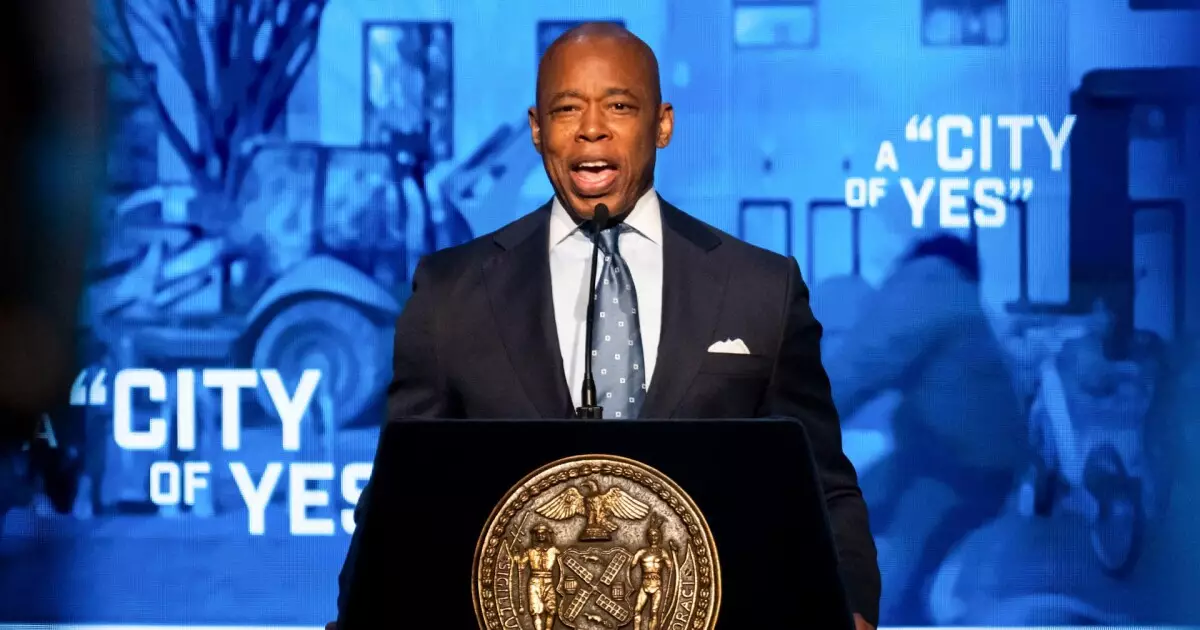The recent budget proposal put forth by New York Mayor Eric Adams has drawn widespread attention due to its magnitude and the context in which it has been framed. With a whopping $114.5 billion allocation, Adams’s spending plan aims to bolster support for social services, a necessary endeavor in a city grappling with complex socio-economic issues. This budget marks a significant shift from prior iterations: not only does it exceed the previous budget by over $2.5 billion, but it also moves away from an austerity-focused approach that has characterized much of the mayor’s tenure.
What stands out in this proposal is its break from the trend of searching for agency savings or imposing cuts. Mayor Adams attributes this refreshing change to effective fiscal management and a stronger-than-expected economy, a suggestion that raises eyebrows among critics and supporters alike. While the optimism about the city’s financial health is commendable, the implications of such projections deserve critical examination.
A crucial element justifying increased expenditures is the reduction in projected costs associated with the influx of migrants. Initially, the Adams administration anticipated spending upwards of $12 billion for services related to over 230,000 new arrivals since April 2022. However, expenditures have totaled approximately $6.91 billion, leading some city officials to surmise that the initial predictions were exaggerated. The chair of the City Council Finance Committee, Justin Brannan, noted that the recognition of these overestimations comes in the wake of three years of budget cuts, suggesting a paradoxical situation where good news is overshadowed by previous austerity measures.
The changes to shelter policies and service contracts have contributed to this fiscal windfall, allowing for the number of migrants in shelters to drop from over 69,000 to below 50,000. While these measures may appear prudent, one cannot ignore the larger implications for social support systems across the city that prioritize vulnerable populations beyond just migrant communities. The mayor’s budget reflects a trend towards temporary solutions that may not adequately address long-term needs.
An interesting juxtaposition arises when exploring the optimism surrounding tax revenue projections. Mayor Adams forecasts an additional $3.1 billion in tax revenues, largely attributed to robust business tax receipts and a resurgence in tourism expected to match pre-pandemic levels by 2025. While this positive outlook is essential for economic forecasting, it carries inherent risks. The slower growth rate in property tax revenue compared to pre-pandemic figures raises a red flag about the sustainability of this financial forecast.
Moreover, looming budget deficits projected for future fiscal years—amounting to $4.2 billion in 2027 and increasing over the following years—paint a stark contrast to the current optimism. This serves as a reminder that the financial landscape can shift rapidly, and reliance on ephemeral boosts, such as transient tourism spikes, leaves the city’s fiscal integrity vulnerable.
The backdrop of this budget is not without its controversies, particularly given Mayor Adams’s current political struggles amidst serious allegations of felony bribery and campaign finance violations. Critics argue that the proposed budget reveals an underlying hesitation to address the consequences of prior fiscal overreach. The political ramifications of these accusations leave an indelible mark on public perception of the administration’s credibility regarding fiscal stewardship.
Additionally, the city’s future relationship with the incoming Trump administration presents an uncertain landscape. Any implications for federal funding, totaling approximately $7.9 billion annually, calls for strategic scenario planning. Deputy Mayor Fabien Levy’s assertion that the city is taking a uniquely proactive stance suggests an effort to navigate these turbulent waters without repeating previous tensions between City Hall and Washington.
As the City Council takes up the proposed budget, it is imperative that both policymakers and the public engage in a thoughtful discourse about its long-term implications. While Mayor Adams’s budget reflects necessary investments in social services amidst a recoverable economy, it must be analyzed within a framework that prioritizes sustainable growth and accountability. The serious financial challenges looming on the horizon call for a balanced perspective that reconciles optimistic forecasts with realistic planning.
To pave the way for a prosperous future, city officials must move beyond temporary fixes and attend to the deeper systemic issues that impact not only migrants but all New Yorkers. Ultimately, the city’s commitment to equitable fiscal management will be tested by its ability to anticipate challenges while investing in its diverse communities.

